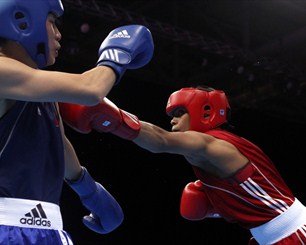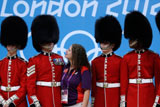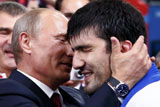Boxing
Updated: 2012-05-14 16:19:43
( london2012.com)
|
|||||||||||
The ever-popular men's Boxing events are joined on the Olympic programme by women's events for the first time.
Boxing featured at the original Olympic Games in the 7th century BC, when opponents fought with strips of leather wrapped around their fists. The sport's regulations were codified in 1867 as the Marquess of Queensberry Rules, named in honour of the nobleman who endorsed them. The essence of these rules is still in place today, governing this exciting and dramatic Olympic sport.
 |
Competition dates
July 28 - Aug 12
Competition venue
ExCeL
Number of medal events
13 - 10 men's weight categories; three women's weight categories
Number of competitors
286 (250 men and 36 women). Each country is limited to one athlete in each weight category.
Field of play
The boxing ring is 6.1m x 6.1m inside the ropes, which are 1.32m high.
History of Boxing at the Olympic Games
Since the first Olympic Boxing competition in St Louis 1904, many of the sport's biggest names have come to prominence at the Games: Cassius Clay (later known as Muhammad Ali; 1960), George Foreman (1968) and Oscar de la Hoya (1992) have all won Olympic gold in the past.
The basics
The Olympic Boxing competition will feature 10 men's weight categories, from Light Fly Weight (46-49kg) to Super Heavy Weight (over 91kg). Women's Boxing will feature as a full Olympic medal event for the first time, with medals in three weights: Fly Weight (48-51kg), Light Weight (57-60kg) and Middle Weight (69-75kg).
Men's bouts take place over three rounds of three minutes each; women's bouts are four rounds of two minutes each. Boxers score points for every punch they land successfully on their opponent's head or upper body.
If a boxer is knocked to the ground and fails to get up within a count of 10 from the referee, the bout is over. Bouts can also be won or lost due to retirement or disqualification. A referee can also decide to stop the fight at any point if they think a boxer is unfit to continue.
Competition format
Both the men's and women's Boxing events are run in a single elimination format. The draws for the men's weight categories contain either 16, 26 or 28 boxers, depending on the category. The women start with a draw of 16 or at the quarter-final stage.
The winners of the two semi-finals in each weight category compete for the gold medal. The losers of the semi-finals are each awarded a bronze.
Officials
A referee is in the ring with the two boxers. The wellbeing of the boxer is the primary concern of the referee, who also ensures that all hits are legal, provides the count when a boxer is down, and has the power to stop the fight at any time.
Five judges sit at the side of the Boxing ring. They watch the bout and individually award points for what they judge to be successful hits.
Keys to success
Boxing is a tough and demanding sport. While weight and height are a distinct advantage, brute strength alone is not enough. Speed, tactics and quick thinking are all crucial if a boxer is to be successful.
Breaking the rules
Boxers who do not obey the instructions of the referee, box in an unsportsmanlike manner, or commit fouls can be cautioned, warned or disqualified by the referee. Types of foul include hitting an opponent below the belt or on the back, tripping or kicking an opponent, and making unfair use of the ropes.
Jargon buster
Hook - a short, sideways-thrown punch delivered with a bent elbow.
Jab - an arm's-length, straight-thrown punch.
Standing eight count - a precautionary count during which the referee allows a boxer time to recover from a heavy blow or series of blows.
Throw in the towel - the traditional way for a boxer's assistant to concede defeat for his/her boxer before the end of the contest.
Medal Count |
||||
| 1 | 46 | 29 | 29 | |
| 2 | 38 | 27 | 22 | |
| 3 | 29 | 17 | 19 | |
| 4 | 24 | 25 | 33 | |
| 5 | 13 | 8 | 7 | |
| 6 | 11 | 19 | 14 | |
















